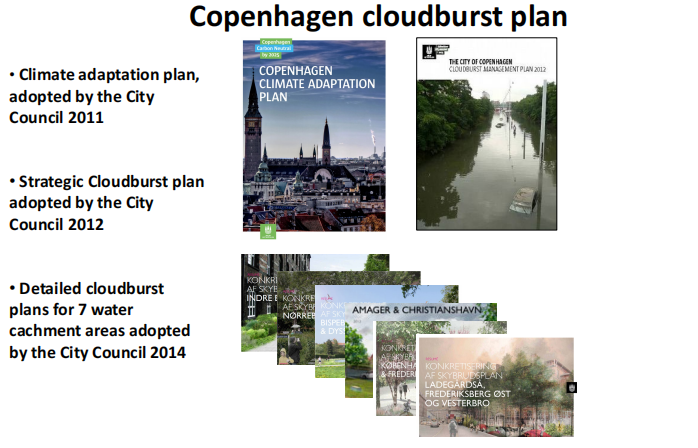COPENHAGEN, DENMARK
Copenhagen Cloudburst Management Plan, Managing Heavy Rains and Stormwater in Copenhagen

Copenhagen, a coastal city of 630,000+ residents, is frequented by rainfalls, which have become all the more recurrent and heavier due to climate change. Combined with insufficient rainwater management infrastructure, the city has seen repeated sewage and drainage overflows with both environmental and financial implications. In response, the city has launched the Copenhagen Cloudburst Management Plan.
The plan will see to the implementation of 350 projects across the city by 2035. It focuses on managing rainwater through mostly surface solutions, building blue and green facilities as opposed to the traditional grey infrastructure of pipelines. The aim is to make the city more resilient to cloudburst events while creating public spaces for recreation. So far, 13 projects have been completed. Tasinge Plads (Tasinge Square), the first demonstration project, has seen the transformation of 1,000 square metres of unused asphalt into green areas. A variety of trees, grasses, and flowers have been planted from lakeside to hillside, according to the land’ conditions and scenarios. This has provided ample sustenance for the birds and insects and, furthermore, contributed to the restoration of the ecosystem in and around the square.
However, such transformation and ambition do not materialise cheaply: the plan is estimated to cost 1.7 billion euros. To finance the implementation, the municipality has garnered enough political support for a law change that enables partnership with the local utility company. The majority of the implementation costs will be covered by water tax charged by the utility company, which also manages a large number of the projects. As many of these projects carry a place-making nature, the city takes care to ensure that each project attends to the characteristics of the district as well as the needs of the local residents. This is done in the form of resident meetings and hearings intended to solicit ideas for to-built recreational green spaces.
This initiative addresses in particular SDGs 6 (clean water and sanitation), 9 (industry, innovation, and infrastructure), 11 (sustainable cities and communities), 13 (climate action), and 15 (life on land).


 In Focus | World Cities Day: People-Centred Smart Cities
In Focus | World Cities Day: People-Centred Smart Cities City Stories | Fostering community resilience: A lifeline for the Central African Republic
City Stories | Fostering community resilience: A lifeline for the Central African Republic In Focus | Innovative Education, Empowering Futures
In Focus | Innovative Education, Empowering Futures




















 Tel: +86 020 3780 4434
Tel: +86 020 3780 4434 Email: info@guangzhouaward.org
Email: info@guangzhouaward.org Address: Unit 01-7, 28th Floor, No. 7, Chunrong 3rd Road, Tianhe District, Guangzhou, Guangdong, 510000, PRC
Address: Unit 01-7, 28th Floor, No. 7, Chunrong 3rd Road, Tianhe District, Guangzhou, Guangdong, 510000, PRC




